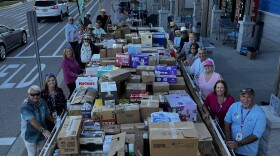MICHEL MARTIN, HOST:
President Trump has said his aggressive tariff moves are about bringing manufacturing back to the U.S. But it turns out that thinkers and politicians from different perspectives have been working to do that. But why? What makes manufacturing so crucial? Greg Rosalsky from NPR's Planet Money team looks at one answer.
GREG ROSALSKY, BYLINE: Over the last 50 years or so, free trade and computers transformed America's economy, and opportunities became increasingly concentrated in big cities. The economies of these cities grew like bananas. Meanwhile, many towns that lost factories saw the reverse - an unwinding, a loss of good jobs, communities struggling.
OREN CASS: When you lose manufacturing and industry, you end up with all of the growth and opportunity concentrating in urban areas with certain types of workers. And we've seen that pattern in recent decades.
ROSALSKY: That's Oren Cass, the chief economist and founder of American Compass, a conservative think tank. Cass says he supports policies like tariffs to bring back manufacturing. One reason is he hopes it can give places like America's heartland a greater chance for economic growth. And the economic theory behind this idea is actually pretty fascinating. Gordon Hanson, an economist at Harvard Kennedy School, says for a community to see a lot of economic growth, it has to export something. It has to sell something to people outside the community.
GORDON HANSON: You don't have to export to the rest of the world, but you got to export to somebody outside the city boundaries - rest of the state, rest of the country. And that's because you're not going to grow just by selling to yourself.
ROSALSKY: Manufacturing is known in economics as a tradable sector. Tradable sectors pull in wealth from outside the community. There are many other tradable sectors, like tech, farming, tourism. Nontradable sectors, on the other hand, tend to circulate wealth that already exists in a community. Think like local restaurants, gyms and barbershops.
CASS: You know, the way I always put it is, like, we can't all just be cutting each other's hair.
ROSALSKY: And one special thing about tradable sectors is that the new money they bring into the community creates jobs in other sectors. Economists call this a multiplier effect. The size of this effect can vary. Like, for each job in the manufacturing sector, estimates suggest that 1.6 additional jobs get created in the local community outside of manufacturing. By comparison, the average tech job creates five additional jobs. But manufacturing is actually pretty diverse. High-end manufacturing jobs like, say, making computers or computer parts - those can get pretty close to matching the multiplier of tech jobs. So, yeah. That's why Oren Cass has hope that more Made In America can revitalize lots of America.
CASS: Manufacturing isn't the only answer, but manufacturing is a good answer. And there are a lot of places where manufacturing is a much more likely answer than some of the things that we've seen be successful elsewhere.
ROSALSKY: Now, there are big questions whether policies like tariffs can actually do much to bring factories back to America. In fact, Gordon Hanson, together with others, recently published a paper that found that President Trump's tariffs during his first term failed to do much to revitalize America's heartland. They might have even been mildly negative for those communities.
Greg Rosalsky, NPR News.
(SOUNDBITE OF GANG STARR SONG, "WHAT'S REAL") Transcript provided by NPR, Copyright NPR.
NPR transcripts are created on a rush deadline by an NPR contractor. This text may not be in its final form and may be updated or revised in the future. Accuracy and availability may vary. The authoritative record of NPR’s programming is the audio record.








